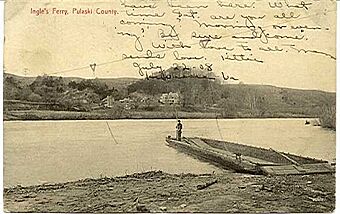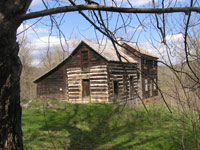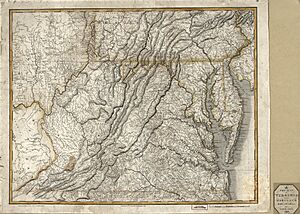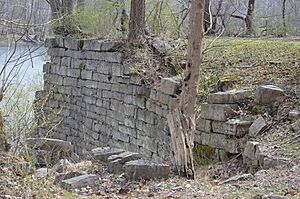Ingles Ferry facts for kids
|
Ingles Ferry
|
|

Ingles Ferry in 1908
|
|
| Location | Radford, Virginia, USA |
|---|---|
| Area | 2 acres (0.81 ha) |
| Built | 1772 (tavern) |
| NRHP reference No. | 69000275 |
Quick facts for kids Significant dates |
|
| Added to NRHP | November 25, 1969 |
Ingles Ferry (sometimes called English Ferry) is a historic place in western Virginia, near the city of Radford. It was once a very important ferry crossing on the New River. A tavern opened here in 1772. The ferry helped soldiers and regular people cross the river until 1948. A bridge was built at this spot in 1842. Sadly, it was burned during the Civil War. Today, you can still see the old tavern. You can also see copies of the 18th-century homes where the Ingles family lived.
Contents
A Look Back at Ingles Ferry
Long before Europeans arrived, Native Americans used this river crossing. They called the area Eagle Bottom. In the mid-1700s, William Ingles and his wife, Mary Draper Ingles, started a farm on the east side of the New River. This was a few years after Mary escaped from the Shawnee Indians in 1755.
By 1760, William Ingles was already earning money. He used his ferry to help troops cross the New River during the Anglo-Cherokee War. He saw how valuable the ferry was and bought the land. In November 1762, Ingles Ferry was officially approved. It cost 3 pence to cross with a person or a horse. In 1766, Ingles asked for permission to open a tavern there.
In its early years, the farm and ferry were often attacked by Native Americans. To keep his family and neighbors safe, Ingles built a small fort. He called it Fort Hope.
The Ingles Ferry Tavern
In 1772, William Ingles finished building the Ingles Ferry Hill Tavern. He also built a blacksmith shop. These were on the Pulaski County side of the river. The tavern became a popular stop for travelers. Famous people like Daniel Boone, Andrew Jackson, and George Rogers Clark visited it.
In 1797, Louis Philippe I, who later became the King of France, crossed the river on the ferry. However, he did not stop at the tavern. William Clark of the famous Lewis and Clark expedition crossed the ferry at least five times between 1801 and 1820.
William Ingles was also in charge of keeping the road to Ingles Ferry in good shape. This road was known as Ingles Ferry Road. It later became a major route and part of the Great Wagon Road and the Wilderness Road.
In 1779, Lord Henry Hamilton, a British prisoner, stayed at the Ingles' home. He wrote in his journal that the area was "romantic." He described the river as "beautiful" and the hills as "well wooded."
By 1780, William Ingles owned a large farm. He had 907 acres, 67 cattle, and ten enslaved people. These enslaved people helped run his ferry and worked on his farm. After William Ingles died in 1782, his son Thomas Ingles took over the ferry. Mary Draper Ingles passed away at Ingles Ferry in 1815.
The Toll Road Era
After the American Revolutionary War, many people moved through the New River Valley. They were heading to new lands in Kentucky and Tennessee. Sometimes, 30 or 40 wagons would stay overnight at the ferry.
In 1805, William's son John Ingles and Andrew Lewis Jr. helped pass a law. This law allowed them to collect tolls on the Allegheny Turnpike. This road is now known as the Valley Pike. The tolls helped pay for keeping the road and ferry in good condition. The turnpike opened in 1809. It was 25 feet wide and over seven miles long. A gate and a toll house were built near Shawsville.
Thomas Ingles, William and Mary Draper Ingles' grandson, took over the ferry in 1832. By 1834, about 20,000 people used the ferry each year. This included large groups of people being transported westward. In the 1830s, Thomas fixed up and made the tavern bigger. He also built a ferry house. The state of Virginia paved the road in 1840.
The Ingles Bridge and Later Years
In 1842, Thomas Ingles built a covered bridge across the New River. It cost $17,000. He still offered ferry service until 1847. The bridge was finished in February 1843. It was 28 feet wide, 20 feet above the water, and 600 feet long. By 1848, the bridge tolls brought in almost $1,900 a year. However, Ingles said that "a large portion of the county people are permitted to cross free of charge."
Money from tolls went down after the Virginia and Tennessee Railroad bridge was built in 1855. This new bridge was about two miles downstream from Ingles Ferry.
On May 9, 1864, after the Battle of Cloyd's Mountain, Confederate soldiers crossed the New River on Ingles Bridge. Union forces then burned the bridge. You can still see the stone supports (called abutments) on the west bank. Ingles Ferry was also the site of one of the last battles of the Civil War. This happened on April 12, 1865, just three days after the Confederate surrender.
In 1865, the Ingles Ferry started working again. It continued until 1939, when the last flat-bottom ferry boat sank. The ferry was briefly used again from 1944 to 1948. The ferry house, built in 1840, was used until a fire destroyed it in 1967.
Discovering the Past: Archaeology
The Ingles Bottom Archeological Sites are places where scientists have dug to find clues about the past. They have found things from both historic times and prehistoric times. These include the Ingles family home, farm, stables, and a family cemetery. John Ingles' 1789 home, called Ingleside, is also nearby.
In 1974, digs covered a large area and found over 30,000 items from the late 1700s. They found a tannery (a place where animal hides are made into leather). They also found the foundation of Mary Draper Ingles' one-room cabin. This cabin was still standing in 1910. Archaeologists also found proof of a Native American village from 1250-1500 CE. They found tools made of stone and bone, and shells, dating back to 3000-1500 BCE.
Ingles Ferry's Legacy
In November 1969, Ingles Ferry was added to the National Register of Historic Places and the Virginia Landmarks Register. The three owners of the property are all direct descendants of Mary Draper Ingles. They have protected the 313-acre land with a special agreement. This agreement means the land will stay natural and historic forever.
You can still see the old tavern and parts of the original Wilderness Road at the site. Copies of the 18th-century Ingles family homes are on the eastern side of the river. This area is also protected.
In 2022, a historical marker was placed at the intersection of West Main Street and Wilderness Road. Another marker, put up in 1998, describes Ingles Ferry Road.









